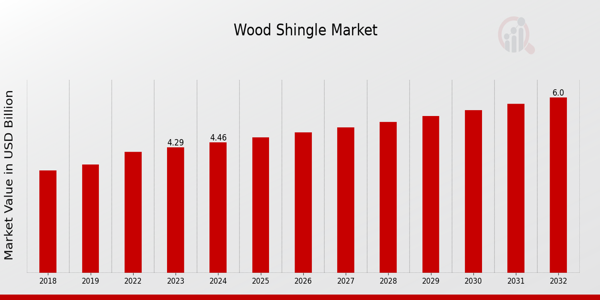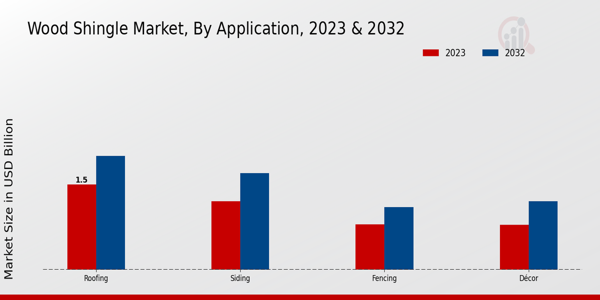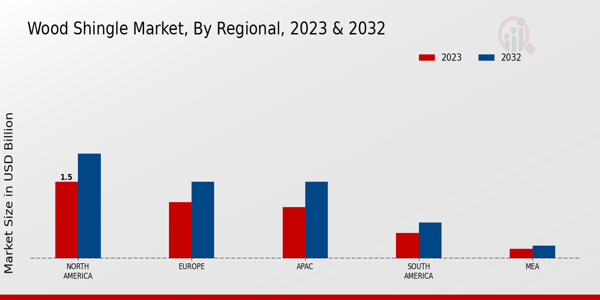Global Wood Shingle Market Overview
The Wood Shingle Market Size was estimated at 4.63 (USD Billion) in 2024. The Wood Shingle Industry is expected to grow from 4.80(USD Billion) in 2025 to 6.72 (USD Billion) by 2034. The Wood Shingle Market CAGR (growth rate) is expected to be around 3.8% during the forecast period (2025 - 2034).
Key Wood Shingle Market Trends Highlighted
The Wood Shingle Market is expected to register strong growth during the forecast period owing to an increase in consumers for natural and sustainable building materials. There is a growing preference for energy efficient construction practices as well as aesthetic properties of wood shingles which attracts builders and homeowners. In addition, there is a growing demand for energy-efficient buildings and wood which provides better thermal insulation is among the preferred structural material. The existence of building rules and standards promoting sustainability will enhance growth of the market while the construction and renovation activities occurring ly will also boost growth. Some of the opportunities to be tapped in the Wood Shingle Market include the scope for enhanced wood treatments and wood coatings to be developed which provide extended life to timber and also make them resistant to moisture and insects.
Manufacturers can also tap into the growing trend of urbanization, as more residences and urban development’s seek attractive and sustainable roofing solutions. Moreover, the increasing interest in DIY projects provides a potential consumer base that values wood shingles for their ease of installation and natural look. Recent trends indicate a shift towards more customizable wood shingle options, including different styles, colors, and finishes that cater to diverse consumer preferences. There is also a rise in the popularity of reclaimed wood shingles, which appeal to eco-conscious consumers looking for unique and historical elements in their homes.
The integration of technology in the production of wood shingles is becoming prominent, allowing for enhanced durability, and reduced environmental impact. These trends reflect a broader movement towards sustainable living which is shaping consumer choices in the Wood Shingle Market. As this market evolves, it continues to align with broader shifts towards sustainability and customization in architecture and design.

Source Primary Research, Secondary Research, MRFR Database and Analyst Review
Wood Shingle Market Drivers
Increasing Demand for Eco-Friendly Construction Materials
The growing awareness and demand for sustainable and eco-friendly construction materials is a significant driver for the Wood Shingle Market Industry. As more consumers and builders lean towards green building practices, the use of wood shingles has gained popularity because they are made from natural materials, have a lower carbon footprint, and can be sourced from sustainably managed forests. This shift towards environmentally responsible choices in construction is not only fostering preferences for wood shingles but also encouraging manufacturers to adopt more sustainable practices in sourcing and production.
A rise in regulations promoting the use of sustainable materials further strengthens this trend. As markets evolve and eco-consciousness rises, the Wood Shingle Market is expected to experience enhanced growth, driven predominantly by the construction industry's pivot towards more responsible material selections. Additionally, as consumer preferences evolve to favor aesthetic appeal coupled with environmental responsibility, wood shingles naturally meet these needs.
Their versatility, durability, and natural beauty make them a preferred choice for residential, commercial, and architectural applications, proving that eco-friendly alternatives can be both functional and visually appealing. This increasing shift towards sustainability is not just a passing trend; it is becoming a central theme in modern architecture and design, leading to wider adoption of wood shingles as primary roofing solutions across various regions.
Rising Construction Activities in Emerging Economies
The rapid urbanization and economic growth in emerging economies are propelling construction activities significantly, thus driving the Wood Shingle Market Industry. Countries experiencing demographic shifts and population growth often initiate large-scale residential and commercial projects, where the demand for roofing materials, including wood shingles, is on the rise. As new housing projects are launched and connectivity improves through infrastructure developments, wood shingles become a preferred choice due to their aesthetic appeal and functional benefits.
Additionally, an increase in disposable incomes allows more individuals to invest in quality housing, further augmenting the market for wood shingles.
Technological Advancements in Wood Shingle Manufacturing
Technological innovations in the manufacturing processes of wood shingles have significantly enhanced production efficiency and product quality, serving as a prominent driver for the Wood Shingle Market Industry. Advanced techniques not only streamline production but also improve the durability and longevity of the products, making them more appealing in the competitive building materials market. These advancements have led to enhanced design options and customization possibilities for consumers, meeting diverse roofing needs and preferences.
As technology continues to evolve, the market is likely to see continuous improvements that will further stimulate growth and adoption of wood shingles in new construction and renovations.
Wood Shingle Market Segment Insights
Wood Shingle Market Application Insights
The Application segment of the Wood Shingle Market exhibits remarkable growth dynamics, underscoring its multi-faceted utility in diverse construction and decorative applications. In 2023, the total valuation for this segment stands at 4.29 USD Billion, with a growing trend anticipated toward 6.0 USD Billion by 2032. Notably, the Roofing application holds a significant share, valued at 1.5 USD Billion in 2023 and projected to increase to 2.0 USD Billion by 2032, demonstrating its major presence in the overall market. As one of the most prevalent applications, Roofing dominates the segment due to its functional role in weatherproofing structures while providing aesthetic appeal. Following closely is the Siding application, which is worth 1.2 USD Billion in 2023 and is expected to grow to 1.7 USD Billion by 2032. This segment remains significant as wood siding not only enhances the aesthetic profile of buildings but also contributes to thermal insulation and energy efficiency, reflecting trends in sustainable urban development.
The Fencing application, valued at 0.8 USD Billion in 2023 and projected to reach 1.1 USD Billion by 2032, represents a robust segment often utilized for creating privacy and security around residential properties as well as enhancing outdoor spaces, thus supporting an increased demand for eco-friendly materials in home landscaping. Lastly, the Décor segment is gaining traction with a current value of 0.79 USD Billion in 2023, anticipated to ascend to 1.2 USD Billion by 2032. This application is characterized by its aesthetic value, with wood shingles being employed in various decorative aspects, including wall cladding, outdoor furniture, and artistic installations, making it an appealing choice for homeowners and designers alike.
Overall, the Wood Shingle Market segmentation reveals significant insights into market drivers such as increasing demand for sustainable and aesthetically pleasing building materials, rising construction activities, and a focus on enhancing property value. Challenges such as competition from alternative materials and environmental regulations could influence market dynamics. However, opportunities remain in innovative products and designs that cater to the evolving preferences of consumers, which could further propel the market's growth trajectory. The Wood Shingle Market data reflects a steady upward movement, validating the growing interest in wood shingles across varied applications, with each segment continuing to hold its unique place in the industry.

Source Primary Research, Secondary Research, MRFR Database and Analyst Review
Wood Shingle Market Wood Type Insights
The Wood Shingle Market, currently valued at 4.29 billion USD in 2023, is witnessing a steady growth trajectory, fueled by a variety of wood types utilized in its production. Among these, Cedar is known for its durability and natural resistance to decay, making it a favored choice in residential roofing applications. Pine, recognized for its cost-effectiveness and workability, caters to a significant portion of the market, appealing to budget-conscious consumers. Redwood's aesthetic appeal and long-lasting qualities contribute to its prominence in high-end construction projects.
Spruce, with its light weight and strength, caters to both structural and decorative applications, enhancing its relevance. The market growth is driven by increasing awareness about sustainable building materials and the aesthetic value that wood shingles provide. However, challenges like deforestation and regulatory constraints on wood sourcing may impact future operations. The range of wood types used within the Wood Shingle Market underlines the diverse preferences of consumers and highlights the importance of each type's unique properties in catering to specific market needs.
This segmentation not only reflects the various demands of consumers but also offers opportunities for innovation and product differentiation within the industry.
Wood Shingle Market End Use Insights
In 2023, the Wood Shingle Market is valued at 4.29 USD Billion, showcasing a diverse segmentation rooted in End Use applications such as Residential, Commercial, and Industrial. The Residential segment plays a pivotal role as homeowners increasingly prioritize aesthetic appeal and sustainability in construction materials, driving significant demand. Furthermore, the Commercial segment remains crucial as businesses leverage wood shingles for their natural appeal and durability, fostering a strong market presence. Meanwhile, the Industrial segment, although smaller, contributes to the overall growth with applications in specialized construction and infrastructure projects.
The anticipated growth in these sectors is driven by a mix of trends, including a rising interest in environmentally-friendly building materials and an increasing focus on residential renovations. However, challenges such as supply chain constraints and fluctuating material costs may impact the market. Overall, understanding the dynamics within the Wood Shingle Market segmentation is essential for stakeholders as these segments together contribute to the market's performance and its projected growth in the coming years.
Wood Shingle Market Treatment Method Insights
The Wood Shingle Market, valued at 4.29 USD Billion in 2023, displays a rich segmentation in its Treatment Method category, which is crucial for distinguishing the characteristics and applicability of wood shingles. Among these methods, the untreated segment is recognized for preserving the natural look of wood while positing a challenge in durability, thus appealing to a niche market. Conversely, pressure treated wood shingles are widely accepted due to their enhanced resistance to decay, thus driving a significant portion of the market growth, especially in regions with high humidity.
Fire retardant treated shingles cater to growing safety concerns, making them highly relevant in commercial applications. Similarly, chemical treated wood shingles enable longevity against pests and significant weather conditions, supporting its increasing adoption. The growth in this market reflects a broader trend towards sustainable construction materials, presenting opportunities for innovation in treatment technologies. Considering the overall market projection to reach 6.0 USD Billion by 2032, insights into these treatment methods will continue to be pivotal for stakeholders looking to enhance their position in the Wood Shingle Market industry.
Wood Shingle Market Regional Insights
The Regional segmentation of the Wood Shingle Market shows considerable diversity in market valuations across different areas. In 2023, North America holds a majority with a valuation of 1.5 USD Billion, expected to grow to 2.05 USD Billion by 2032, showcasing its dominant position due to robust housing and renovation activities. Europe follows, valued at 1.1 USD Billion in 2023 and projected to reach 1.5 USD Billion by 2032, driven by aesthetic preferences for wooden roofing materials. The Asia-Pacific (APAC) region, valued at 1.0 USD Billion, is also significant, reflecting its increasing residential construction and renovation projects that emphasize sustainable materials, leading to an expected increase to 1.5 USD Billion by 2032.
South America, with a starting valuation of 0.5 USD Billion and a projection of 0.7 USD Billion in 2032, is growing steadily but remains less dominant. Meanwhile, the Middle East and Africa (MEA) remain the smallest segment at 0.19 USD Billion but are on an upward trend to 0.25 USD Billion, finding opportunities in niche markets. As these market dynamics evolve, growth drivers such as sustainable construction practices and the aesthetic appeal of wood shingles are becoming increasingly vital across these regions.

Source Primary Research, Secondary Research, MRFR Database and Analyst Review
Wood Shingle Market Key Players and Competitive Insights
The Wood Shingle Market is characterized by an array of competitive dynamics shaped by the increasing demand for eco-friendly building materials and aesthetic architectural solutions. This market encompasses a blend of established and emerging players, contributing to a diverse product range and innovation in wood shingle manufacturing techniques. The growing popularity of natural and sustainable materials in construction, coupled with the rising awareness of climate change, has propelled the demand for wood shingles, which are perceived as a sustainable roofing option. Companies in this space are competing not only on quality and pricing but also on their ability to provide customized solutions that meet specific customer requirements while ensuring environmental compliance. This competitive landscape is influenced by various factors, including technological advancements, raw material availability, and regional preferences, all of which shape market trends.
Barkhouse stands as a prominent player within the Wood Shingle Market, known for its commitment to sustainability and high-quality products. The company has carved a niche by sourcing wood from responsibly managed forests, ensuring that its wood shingles not only meet aesthetic expectations but also environmental standards. Barkhouse emphasizes craftsmanship and attention to detail, positioning itself as a premium provider within the market. The company's strengths lie in its established reputation for durability and performance, alongside its ability to customize products according to unique architectural demands. By leveraging its expertise in natural wood materials, Barkhouse successfully caters to a growing consumer demographic that values both sustainability and design, thereby cementing its competitive position in the industry.
Tegral Building Products is another key competitor in the Wood Shingle Market, recognized for its innovative approach and broad product portfolio. The company offers a unique range of wood shingles that are designed to enhance the longevity and aesthetic appeal of buildings while providing effective protection against the elements. Tegral Building Products place a strong emphasis on research and development, consistently striving to improve product performance while addressing the evolving needs of the market. Notably, the company excels in creating shingles that require minimal maintenance, appealing to a customer base increasingly influenced by practicality and durability. Tegral's strategic partnerships with suppliers and a robust distribution network allow it to maintain a strong presence in various regions, thereby boosting its competitive advantage and enabling it to respond swiftly to changing market demands.
Key Companies in the Wood Shingle Market Include
Wood Shingle Market Industry Developments
Recent developments in the Wood Shingle Market indicate a growing demand for environmentally friendly and sustainable building materials, as consumers and businesses increasingly prioritize eco-conscious choices. Companies such as Barkhouse, Tegral Building Products, and Royal Building Products are expanding their offerings to meet this trend, with increased focus on responsibly sourced wood. The market is currently experiencing a surge in valuations, driven by rising construction activities and a push for aesthetics in roofing solutions. This has positively impacted firms like GAF Materials, which have seen an uptick in sales attributed to their innovative product lines. Moreover, acquisition activities are shaping the landscape, with notable interest from large entities such as Terra Firma and Woodhaven Lumber seeking strategic partnerships to enhance their market share. Current economic factors, including supply chain challenges and raw material costs, continue to affect operations for companies like Cape Cod Roofing and Shingle Creek Woodworks, which are adapting to maintain competitiveness. With regulatory changes promoting sustainable practices, the sector is poised for growth, reflecting a significant shift in consumer preferences and industry standards.
Wood Shingle Market Segmentation Insights
Wood Shingle Market Application Outlook
Roofing
Siding
Fencing
Décor
Wood Shingle Market Wood Type Outlook
Cedar
Pine
Redwood
Spruce
Wood Shingle Market End Use Outlook
Residential
Commercial
Industrial
Wood Shingle Market Treatment Method Outlook
Untreated
Pressure Treated
Fire Retardant
Chemical Treated
Wood Shingle Market Regional Outlook
North America
Europe
South America
Asia Pacific
Middle East and Africa
Wood Shingle Market Report Scope
| Report Attribute/Metric |
Details |
| Market Size 2024 |
4.63 (USD Billion) |
| Market Size 2025 |
4.80(USD Billion) |
| Market Size 2034 |
6.72(USD Billion) |
| Compound Annual Growth Rate (CAGR) |
3.8% (2025 - 2034) |
| Report Coverage |
Revenue Forecast, Competitive Landscape, Growth Factors, and Trends |
| Base Year |
2024 |
| Market Forecast Period |
2025 - 2034 |
| Historical Data |
2020 - 2024 |
| Market Forecast Units |
USD Billion |
| Key Companies Profiled |
Barkhouse, Tegral Building Products, Royal Building Products, Terra Firma, Woodhaven Lumber, Cape Cod Roofing, Shingle Creek Woodworks, Barker Cedar, Resawn Timbers, Cedar Shake and Shingle Bureau, Palmer Timber Company, GAF Materials, America's Finest Wood, Tundra Wood, Allwood Wood Products |
| Segments Covered |
Application, Wood Type, End Use, Treatment Method, Regional |
| Key Market Opportunities |
Sustainable building material demand, Eco-friendly construction trends, Increased renovations and remodeling, Growth in real estate industry, Rising awareness of aesthetics |
| Key Market Dynamics |
growing eco-friendly construction demand, increasing durability and longevity, rising aesthetic preferences, fluctuations in raw material costs, regional regulatory considerations |
| Countries Covered |
North America, Europe, APAC, South America, MEA |
Frequently Asked Questions (FAQ) :
The Wood Shingle Market is expected to be valued at 4.63 billion USD in 2024.
By 2034, the Wood Shingle Market is projected to reach a value of 6.72 billion USD.
The expected CAGR for the Wood Shingle Market from 2025 to 2034 is 3.8%.
North America holds the largest market share, with a valuation of 1.5 billion USD in 2023.
The market value for the Siding application is expected to be 1.7 billion USD by 2032.
Major players include Barkhouse, Royal Building Products, Terra Firma, and GAF Materials among others.
The Fencing application is valued at 0.8 billion USD in 2023.
The APAC region is estimated to reach a market size of 1.5 billion USD by 2032.
The Roofing application is valued at 1.5 billion USD in 2023.
The market may face challenges such as fluctuating raw material prices and environmental regulations.


















